Using toricity with scleral lenses
Scleral lenses are indispensable in a specialty contact lens practice. The indications for scleral lens use are well established in the literature and range from visual rehabilitation of irregular corneas to severe ocular surface disease management.1-4 Many more uses may still be revealed.
Scleral lenses are indispensable in a specialty contact lens practice. The indications for scleral lens use are well established in the literature and range from visual rehabilitation of irregular corneas to severe ocular surface disease management.1-4 Many more uses may still be revealed.
The hallmark of scleral lens fitting is vaulting the cornea and limbus and landing on the conjunctiva overlying the sclera. They are called scleral lenses for a reason: they fit the sclera. Much attention is placed on proper corneal clearance; however, equally important is the landing of the periphery of the scleral lens on the ocular surface. We are fitting the scleral shape after all.
Front toric vs. back toric: What’s the difference?
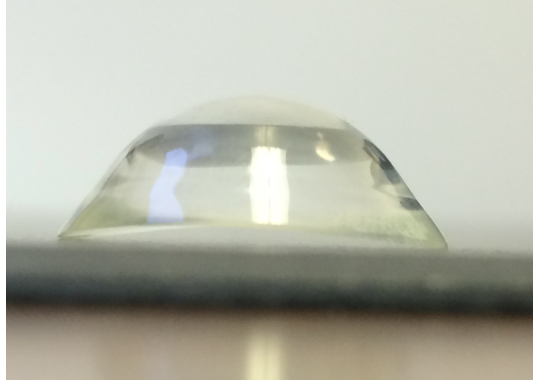
Figure 1a: Back surface toric lens balancing on the steep meridian. Toricity may mean different things depending on the practitioner. Remember, toricity is two different curves separated by 90 degrees and oriented at a given axis. In optics those two different curves have dioptric power that induces astigmatism.
When employing front surface toricity, the effect is optical. Front surface toricity is utilized when astigmatism is revealed with a sphero-cylindrical over-refraction. Orientation is important, and the lens requires stabilization either by way of prism ballasting, dual thin zones, or double slab-off prism in order to provide stable vision.
Back surface toricity is used for lens alignment. Scleral lens back surface toricity is typically found in the peripheral curve/landing zone/haptic system. Figure 1 shows the profiles of a scleral lens with back surface toric curves. It has been shown that scleral asymmetry is increased further from the limbus.5 If the landing zone of a spherical or rotationally symmetric lens is producing asymmetric compression, impingement, or edge lift, then the fit may be improved by employing back surface toricity.
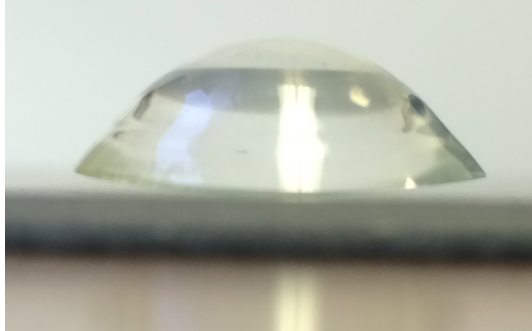
Figure 1b: The same lens where the flat meridian is viewed lifting off the table.To summarize, front surface toricity is an optical feature, and back surface toricity is a fitting feature. Both front and back toricity can be manufactured in the same scleral lens. The result can be excellent lens stability (from the back surface toricity scleral lens alignment) with outstanding optical performance (from the front surface optical toricity).
Next: Benefits of back surface toricity
Benefits of back surface toricity
Lens stability is the trademark of incorporating back surface toricity into the design. One study has shown that once applied and if rotated more than 45 degrees either clockwise or counterclockwise, the lens returns to the original position on average within four seconds.6 Statistically significant improvement and increases in patient comfort, satisfaction, and wearing times also were demonstrated in the same study.
Often peripheral “curve” terminology is used to define back surface toricity. However, peripheries are not necessarily curves in some designs. Referring back to the scleral shape study,5 scleral shape between the junction of limbus and sclera are often tangential in nature. Bitangential scleral lenses with a 20.0 mm diameter were shown to have improvements in comfort.7 In this case, back surface toricity was created with tangent peripheries in each meridian.
Measuring scleral toricity
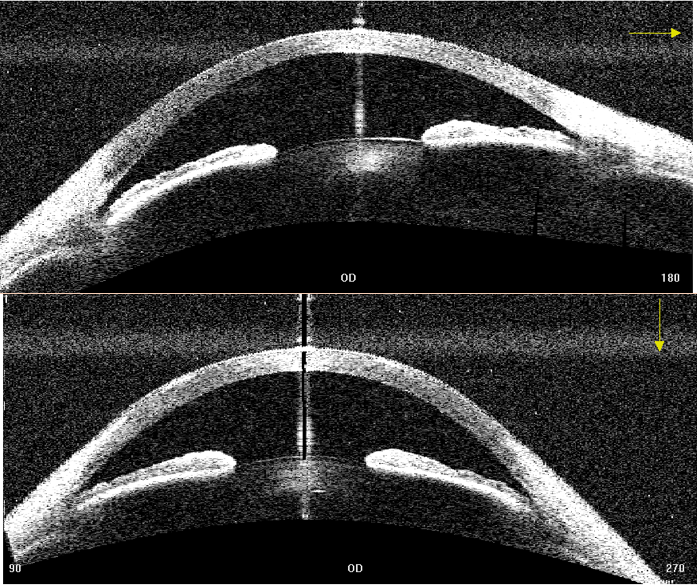
Figure 2: Top: OCT image of horizontal meridian of an eye exhibiting with-the-rule scleral toricity. Bottom: Vertical meridian of same eye. Note the steep curve past the limbus relative to the horizontal image above. Technological tools can help find scleral shape patterns. Optical coherence tomography (OCT) can easily illustrate the difference between a steep and flat meridian. The scleral shape study was conducted using OCT technology.5
An example of scleral toricity is shown in Figure 2 in which the horizontal and vertical meridians of a highly toric eye are shown. Despite the horizontal meridian image not being well-aligned, there still is an impressive difference between the horizontal flat meridian (above) and the vertical steep meridian (below). OCT has also been shown to be effective when empirically fitting scleral lenses.8
Newer technology that maps scleral shape also includes the Eye Surface Profiler (Eaglet Eye, b.v.) and the sMap3D (Precision Ocular Metrology, LLC). Both of these scleral topography instruments have the ability to map scleral asymmetry up to beyond 20.0 mm with proper decentration. Both instruments require fluorescein on the eye for imaging.
Next: Using diagnostic lenses to find the patterns
Using diagnostic lenses to find the patterns

Figure 3: Circumferential compression creates circumlimbal congestion that may be due to minimizing venous outflow. This lens could potentially seal off completely and create a difficult removal for the patient and practitioner.Investing in these technological tools can be expensive. There is an inexpensive and easy way to determine scleral toricity to optimize the fit by using diagnostic lenses. In the case of corneal lenses, one can identify the corneal curvatures and elevations by using diagnostic lenses and fluorescein patterns. Similarly, scleral topography and meridional asymmetry can be determined by observing the scleral lens bearing patterns.
As a review of the basic scleral landing zone and conjunctival relationships, compression causes conjunctival blanching, and it can be observed in any sector of the landing zone or even circumferential (Figure 3). If the compression is significant, then rebound hyperemia occurs after the lens is removed (Figure 4).
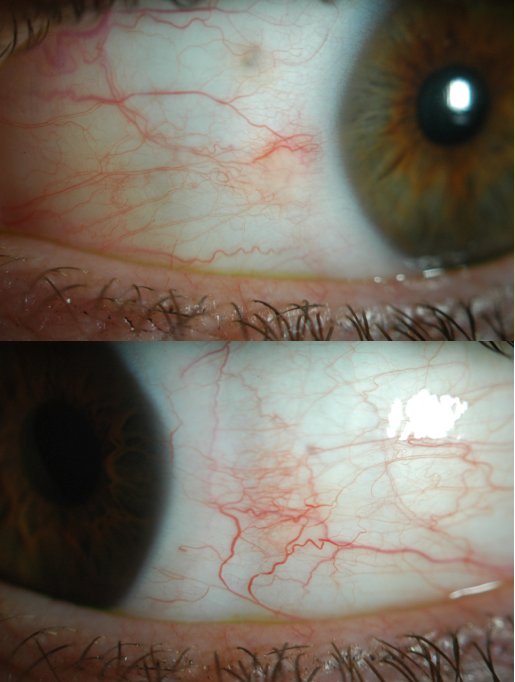
Figure 4: Top: Nasal rebound hyperemia overlying a pinguecula. Bottom: Temporal rebound hyperemia of the same eye. This is an example of meridional rebound hyperemia that was due to compression of the scleral lens. Since the hyperemia is not occurring in the vertical meridian, the sclera is toric and with-the-rule.Impingement occurs when the outermost edge digs into the conjunctival tissue and blanching may or may not be observed.9,10 Impingement will leave behind arcuate staining as shown in Figure 5, and over time, it may hypertrophy (Figure 6). Sometimes if impingement is seen at the edge of the lens, compression may be occurring concurrently with an extremely tight scleral landing zone (Figure 7).
Edge lift, on the other hand, creates no bulbar conjunctival effects; however, it potentially could exacerbate giant papillary conjunctivitis (GPC) on the palpebral conjunctiva. Edge lift creates initial lens awareness. Pulling the lid away from the sector of patent awareness will reduce symptoms immediately and confirm edge-to-eyelid interaction. Fluorescein nicely highlights edge lift similar to a corneal lens (Figure 8).
Steep scleral lens on a toric sclera
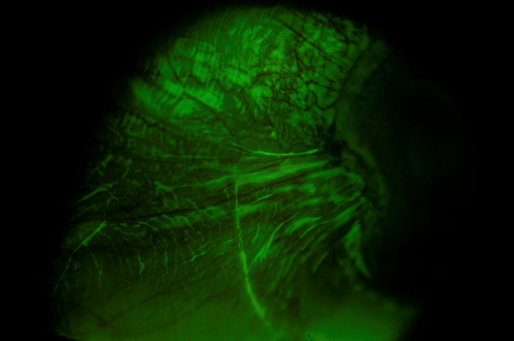
Figure 5: Appearance of sectoral conjunctival arcuate staining as a result of nasal scleral lens impingement.Most fitting sets have standard rotationally symmetric peripheral landing zones. A symmetric scleral lens will reveal patterns on an asymmetric sclera. Whether the scleral lens is tight or flat, using the signs of compression, impingement, and edge lift will highlight a scleral toric pattern.
Often the pattern can be easily observed outside the slit lamp. Immediately after lens application, most practitioners evaluate the lens for bubbles. During that gross examination, meridional compression patterns are easily identified (impingement and edge lift may require a slit lamp).
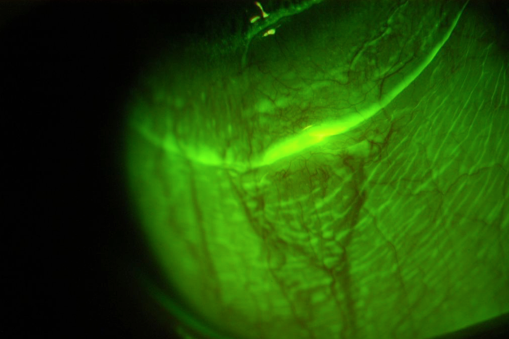
Figure 6: Conjunctival hypertrophy after longstanding scleral lens impingement.Figure 9 is an example of viewing the pattern outside the slit lamp. At first glance, circumferential compression is observed. However, with closer evaluation, the horizontal meridian is demonstrating increased compression with more pronounced limbal injection. This is an example of a steep/tight fitting scleral lens with a symmetric periphery on a with-the-rule toric sclera.
With-the-rule scleral toricity is defined by the horizontal meridian corresponding to the flat meridian and the vertical meridian is steep. Often steep topography values are associated with elevation, but in this case, the sclera is presenting a higher amount of curvature which means that the sclera curves away from the lens. A steep fitting symmetric lens will be tight on the flat meridian; compression, impingement, or both may be observed.
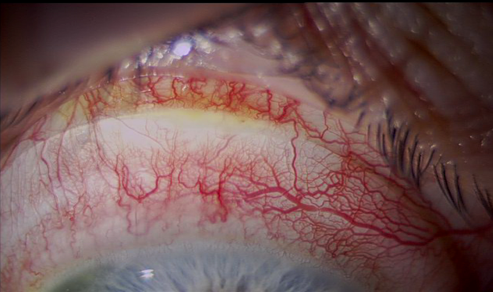
Figure 7: Compression and impingement occurring together at the superior edge of the lens. Compression is observed with the superior band of conjunctival vessel blanching. The area of fluorescein superiorly is lacerated conjunctival tissue overlying the edge from impingement. Note there is mild compression from the 10 to 11 o'clock hours. This demonstrates that compression can occur anywhere in the landing zone, not just the edge. Since the eye is injected, this amount of compression is observed; however if the eye is quiet, likely there would be no evidence of any blanching.However, the steep meridian may demonstrate compression, impingement, or even edge lift depending on the amount of curvature and difference. If compression and/or impingement are observed on the steep meridian, the findings will be significantly less than the flat meridian. Referring back to Figure 4, the flat meridian had been more compressed creating meridional rebound hyperemia in a with-the-rule sclera.
Flat scleral lens on a toric sclera
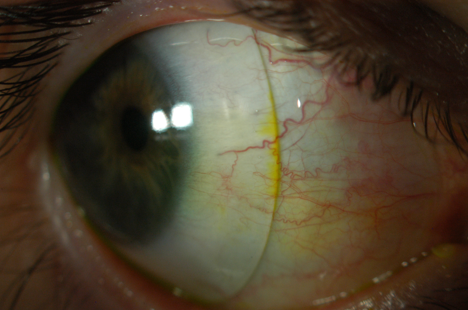
Figure 8: Fluorescein highlighting mild edge lift nasally that would likely go unnoticed without the dye.Conversely, a flat-fitting rotationally symmetric scleral lens will either align or have edge lift on the flat meridian. Remembering that the steep meridian is curving away from the flat meridional scleral plane, the scleral lens will demonstrate much more edge lift on the steep meridian.
With excessive edge lift comes tear exchange, which may also be extreme and may create a path for bubbles and debris (Figure 10). Fortunately, it is easier to tighten a loose-fitting peripheral curve than to try to loosen a tight-fitting lens because the edge lift can be measured.
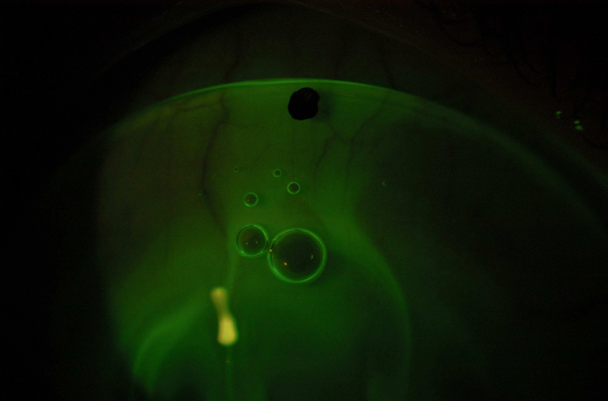
Figure 10 Edge lift with excessive tear exchange and bubble intrusion on a with-the-rule sclera.Figure 11 is an example of a global white and cobalt light view of with-the-rule scleral topography and a flat-fitting scleral lens. Not every sclera is with the rule. Referring back to Figure 7 is an example of against-the-rule because the vertical meridian is displaying the tighter fitting features. The inferior quadrant displays a similar fitting pattern (not shown). Oblique patterns are also possible (Figure 12).
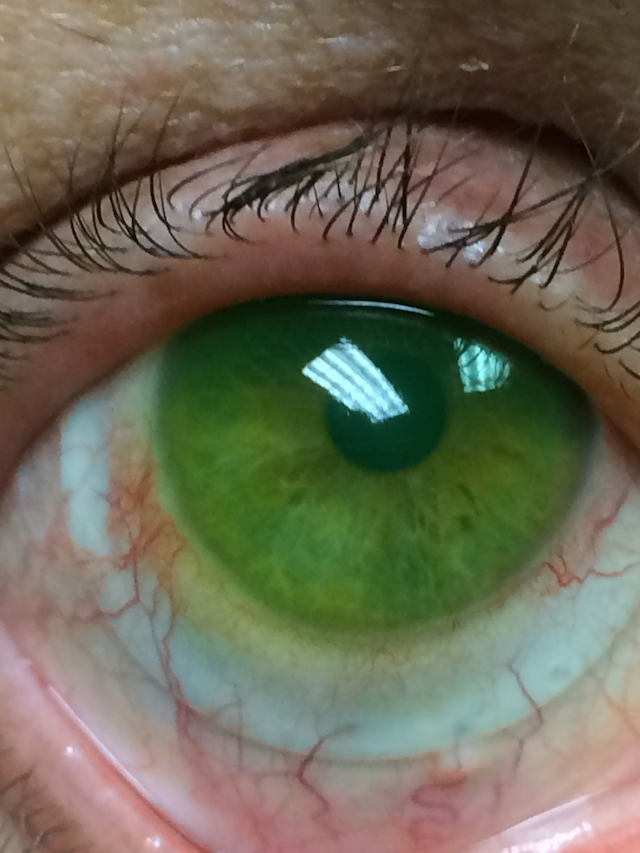
Figure 9. A steep-fitting spherical lens on a with-the-rule sclera.
Piecing it together
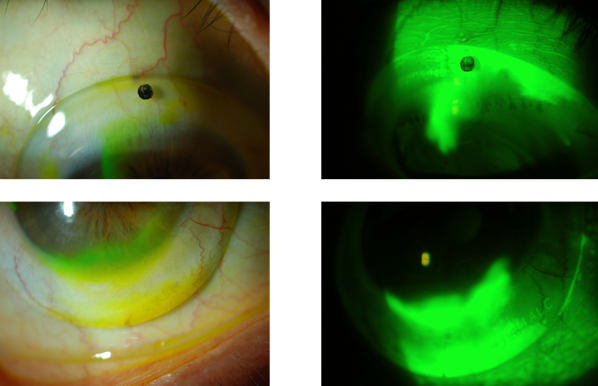
Figure 11: Example of a flat fitting scleral lens on a with-the-rule toric eye. This is the same eye imaged in Figure 2.Once the meridians are identified, evaluate each one independently of the other. Inform the lab that the periphery is toric because not every design is capable of back surface toric peripheries. If there is compression on one meridian, then order flatter peripheral curves, tangents, or angles depending on the design. Conversely, if there is edge lift, order steeper peripheries in that meridian.
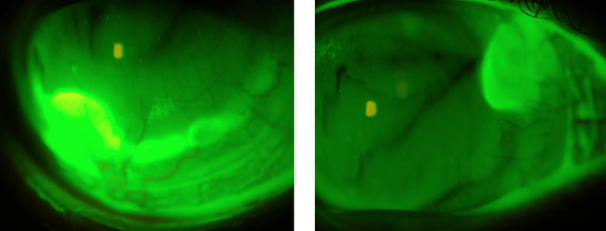
Figure 12: Oblique meridional tear exchange. The tear exchange is associated with the steep meridian. The sclera is curved away from the lens creating a gap for tear exchange to occur.If a toric trial set is available, apply the toric diagnostic lens on the eye to confirm the scleral toricity. A toric diagnostic lens will always have the flat and steep meridians labeled on the lens, and there is typically a laser mark designating one of the meridians. Strategically beginning with a symmetric (non-toric) diagnostic lens first despite the suspicion of scleral toricity can be helpful because there is only one peripheral curve. It can confirm the presence or requirement for toric peripheral curves.
It can be very easy to mix up the meridians when applying a toric diagnostic trial. By beginning with a toric trial, a scenario may occur when the flat meridian needs to be steepened, and the steep meridian requires flattening-this negates a toric lens completely and creates a spherical or symmetric scleral periphery. However, when placing a toric trial lens on a toric sclera, the meridians will align. Here the axis of the meridians can be determined by rotating the beam of the slit lamp to the laser marks (similar to measuring rotation of a soft toric lens). Identifying the axis of toricity becomes important for the lab to mark the lens with a dot in the appropriately designated meridian. It is also important when designing a back surface toric lens that requires front surface toricity.
Back and front surface toricity in the same lens
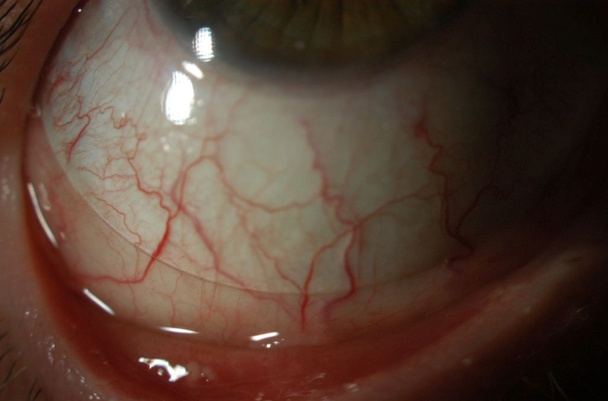
Figure 13: Even vascular pattern and scleral alignment with a 23.0 mm diameter scleral lens using 8 meridians.As stated earlier, back surface toricity is used for scleral alignment and front surface toricity corrects sphero-cylindrical over-refractions. The axis of the back toricity and front optical toricity do not always align. Approach this scenario methodically.
First, determine the flat and steep scleral meridians. If a toric diagnostic set is available, determine the axis of the flat meridian. Specify the changes required for each meridian. For example, the flat meridian may require flattening by two steps from standard, and the steep meridian may require steepening one step from standard. Order a “flat 2/steep 1” with the flat axis at whatever is determined (180 degrees for a with-the-rule sclera).
Next, determine the required sphero-cylindrical over-refraction, remembering to vertex. Make sure the lab is informed whether the over-refraction was vertexed. If there is misalignment of the back surface toricity axis and the optical axis, then the ordered prescription axis would be calculated just like a soft toric lens using left add/right subtract (LARS) technique. Again, notify the lab if the LARS compensation was performed. Sometimes lab consultants prefer the raw data, and they take care of all the calculations for the practitioner.
If a toric fitting set is unavailable and the patient requires front surface toricity, the accurate axis of scleral toricity is not confirmed yet. Order a back surface toric scleral lens with a spherical equivalent power first. Apply that lens to the patient, and then determine the axis of the flat (or steep) meridian. At that point, a sphero-cylindrical lens power can be ordered once the axis of scleral toricity is known in order to provide the patient the best optical performance of the lens. Unfortunately, this is a two-step process. Always be sure to check with the laboratories about their return and warranty policies.
Summary
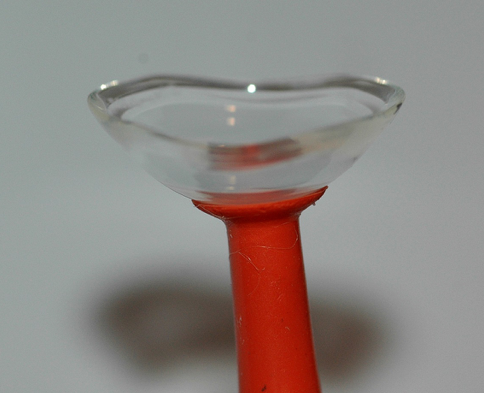
Figure 14: An example of an eight meridian custom scleral lens.There are many benefits of back surface toric peripheral landing zones. Alignment is exceptional and creates a stable and well-balanced lens while also providing a stable platform for front surface optical toricity.
Figure 13 shows a 23.0 mm diameter lens that could not demonstrate even vascular alignment without incorporating peripheral toric, and in this case, eight meridian-specific peripheries. Some labs may have the ability to create quadrant-specific or even eight meridians of alignment.
Figure 14 shows a profile of one these unique lenses. Comfort is significantly improved by eliminating symptoms of edge awareness and end-of-day discomfort from tight lenses by using back surface toricity.
Toric peripheries can increase wearing time and contribute to long-term success by minimizing fit-related complications. By decreasing the path of excessive tear exchange, another benefit is a reduction in debris and fogging that has been very problematic with scleral lens wear. Using technology and standard scleral lens diagnostic sets can be very helpful to design these beneficial lenses for patients.
References
1. Ezekiel D. Gas-permeable haptic lenses. J Br Contact Lens Assoc 1983;6:158-61.
2. Schein OD, Rosenthal P, Ducharme C. A gas-permeable scleral contact lens for visual rehabilitation. Am J Ophthalmol 1990;109:318-22.
3. Kok JH, Visser R. Treatment of ocular surface disorders and dry eyes with high gas-permeable scleral lenses. Cornea 1992;11:518-22.
4. Tan DT, Pullum KW, Buckley RJ. Medical applications of scleral contact lenses: 2. Gas-permeable scleral contact lenses. Cornea 1995;14:130-7.
5. van der Worp E, Graf T, Caroline PJ. Exploring beyond the corneal borders. CL Spectrum 2010;25(6):26-32.
6. Visser ES, Visser R, Van Lier HJ. Advantages of toric scleral lenses. Optom Vis Sci 2006;83:233Y6.
7. Visser ES, Van der Linden BJJJ, Otten H, Van der Lelij, Visser R. Medical applications and outcomes of bitangential scleral lenses. Optom Vis Sci. 2013 Oct;90(10):1078-85.
8. Gemoules G. A novel method of fitting scleral lenses using high resolution optical coherence tomography. Eye Contact Lens 2008 Mar;34(2):80-3.
9. van der Worp E. A Guide to Scleral Lens Fitting (monograph online). Pacific University Common Knowledge: Books and Monographs.
2010. Available at: http://commons.pacificu.edu/cgi/viewcontent.cgi?article=1003&context=mono. Accessed March 31, 2016.
10. van der Worp E. A Guide to Scleral Lens Fitting 2.0 (monograph online). Pacific University Common Knowledge: Books and Monographs. 2015. Available at: http://commons.pacificu.edu/mono/10/ Accessed March 31, 2016
Newsletter
Want more insights like this? Subscribe to Optometry Times and get clinical pearls and practice tips delivered straight to your inbox.